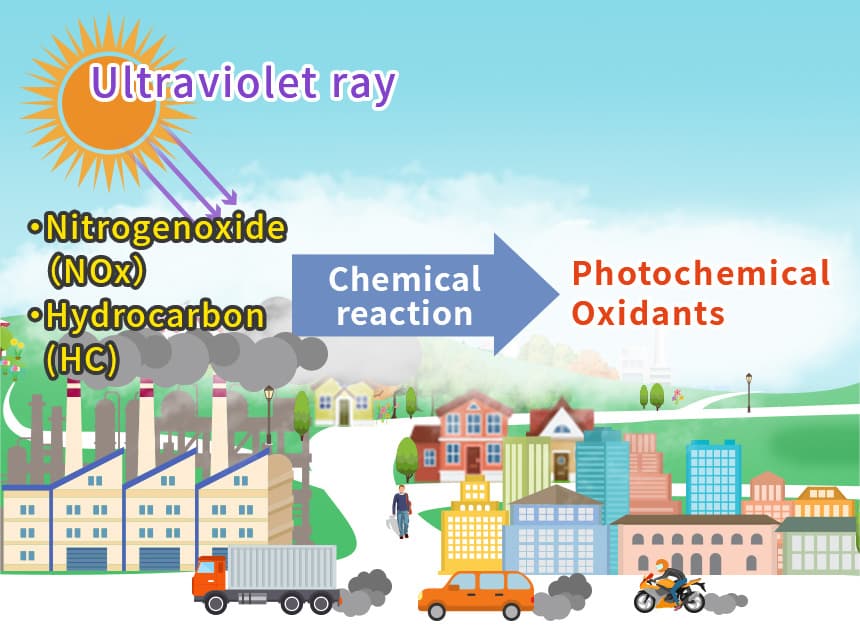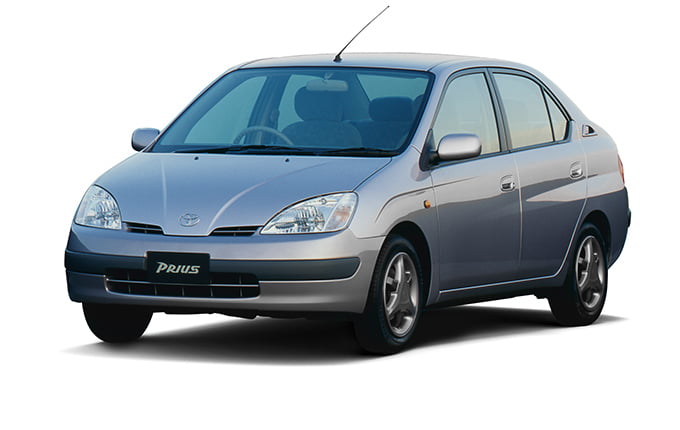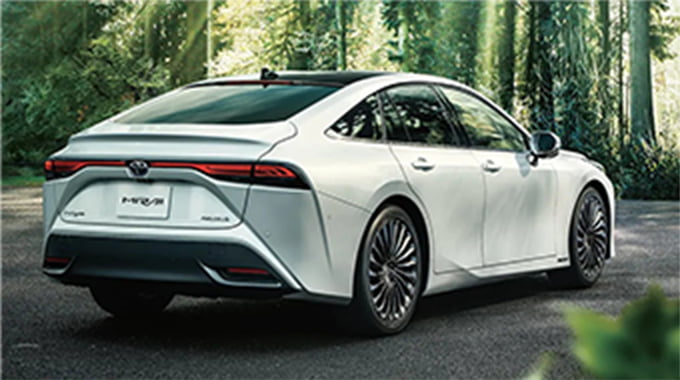- Home
- Automotive catalysts
Automotive catalysts
The most familiar catalyst in our lives is probably the "exhaust gas purification catalyst". "Exhaust gas purification catalysts" are used in internal combustion engines such as automobiles and motorcycles, water bikes, lawnmowers, golf cars, and gas engines responsible for in-house power generation, heating, and hot water supply. The automotive catalyst, one of Cataler's typical products, was commercialized in the 1970s and has been continually improved to this day. Ceramic filters coated with catalysts are installed near the engine or under the floor and may not be visible to the general public, but they are indispensable products to clean toxic gases exhausted from the engine.
It is no exaggeration to say that the catalyst most closely associated with our daily lives is the "emission gas purification catalyst". An "emission gas purification catalyst" is always installed in a prime mover powered by an internal combustion engine (gasoline engine, diesel engine, gas turbine, gas engine, etc.), such as a car or a motorcycle.

The automotive catalyst, our typical product, was put into practical use in the 1970s, and is still in use today with continual improvements being made. Ceramic filters coated with catalysts are installed near the engine, under the floor and in other places that are usually out of sight, so they may not be directly visible to the public, but they are an indispensable technology for cleaning the toxic gases emitted from the engine.

Exhaust gas regulations
During the high economic growth period of the 1970s, air pollution progressed due to industrial development and the widespread use of automobiles. Damage caused by photochemical smog was also reported, and people's interest in air pollution and concerns about health damage were rapidly increasing. In the United States, air pollution became a problem much earlier than in Japan, and in December 1970, the "Muskie Act" was enacted. The automobile emission regulations under this law were as follows.
- Reduce carbon monoxide (CO) and hydrocarbon (HC) emissions from vehicles manufactured after 1975 to 110th or less of the emissions from 1970-1971 models.
- Reduce nitrogen oxide (NOx) emissions from vehicles manufactured after 1976 to 110th or less of the emissions from 1970-1971 models.
* In 1978, the "1978 Exhaust Emission Regulations," known as the Japanese version of the Muskie Act, started in Japan. At that time, "CO of 2.1 g/km, HC of 0.25 g/km, and NOx of 0.25 g/km or less" were the strictest values in the world.
First occurrence of photochemical smog in Japan
In July 1970, about 6,000 people, mainly in Suginami Ward, Tokyo, suffered from sore eyes and throats and more than 40 students at Tokyo Rissho High School in the same ward fell ill with poisoning symptoms. The cause was thought to be a combination of photochemical smog and sulfuric acid mist. After that, similar cases occurred in Mitaka City, Kunitachi City, and Saitama Prefecture's Kawaguchi City, and more than 1,200 people were affected.

An example of photochemical smog
(Dhaka, Bangladesh)
What is photochemical smog?

Nitrogen oxides (NOx) emitted from automobiles and factories, and hydrocarbons (HC) contained in gasoline and paint thinner are exposed to the sun's strong ultraviolet rays and transformed into new substances called photochemical oxidants (Ox) through photochemical reactions. Photochemical oxidants have a high concentration of HC and NOx in the atmosphere, and when the ultraviolet rays are strong, they appear white and hazy. This phenomenon is called "photochemical smog", and when the concentration becomes high, it affects people and plants. Effects on the human body include those reported for mucous membranes of the eyes and throat, such as "flickering eyes", "sore throat", and "difficulty breathing".
Less than 1100 emissions of harmful substances
After the implementation of the so-called "Emission Regulations in 1978" (1978), the regulations continued to be worked out in finer detail, but in 2000, the regulations were significantly tightened (Emission control regulations enforced in the year 2000). The emission control regulations in 2000 set emission limits for carbon monoxide (CO), hydrocarbons (HC), and nitrogen oxides (NOx) at approximately 70% below the 1978 limits, and mandated the installation of on-board diagnostic monitoring (OBD) systems. In addition, with the implementation of tax reduction measures under the low-emission vehicle certification system (commonly known as "eco-car tax reduction"), automakers competed to reduce passenger car emissions of harmful substances to less than 1100th of the levels before the regulations of the 1960s.
Image of global exhaust gas regulations after the Muskie Act
Swipe sideways to view the table.


Photo courtesy: Toyota Motor Corporation
First generation Prius (1997-2003)
The Toyota Prius, the world's first mass-produced hybrid electric vehicle, was launched with the catchphrase "Just in time for the 21st century" (Shunichi Iwasaki). The hybrid electric vehicle (HEV) was derived from the word "hybrid," which means "a combination of different elements," because it has two sources of power, an engine and an electric motor. It is the first eco-car of the 21st century that achieves about twice the fuel efficiency and half the CO2 emissions of gasoline-powered cars of the time, while maintaining the same driving performance.
* "CATALER inside" is a registered trademark of Cataler Corporation
Cataler exhaust gas purification catalyst products
Exhaust gas purification catalysts are installed in places that are usually out of sight and may be overlooked, but they are essential parts for clean exhaust gas. If you look under the floor of a car or truck, there is a muffler (silencer) near the exhaust port, and next to (in front of) the muffler is a catalyst housed in a smaller container. (Depending on the vehicle model, there are cases where two or more catalysts are installed instead of one)


- 1Gasoline engine catalysts
- Toxic substances (hydrocarbons, carbon monoxide, nitrogen oxides) in exhaust gases are converted into nitrogen, water, and carbon dioxide through oxidation and reduction reactions by catalysts coated in the holes of the ceramic or metal honeycomb structure. Exhausted as harmless components

- 2Diesel engine catalysts
- By coating a catalyst onto the filter-like material, when exhaust gases pass through the filter wall, it removes hydrocarbons, carbon monoxide, and particulate matter (soot, etc.) specific to diesel vehicles.

- 3Motorcycle catalysts
- These utilize a metal honeycomb carrier, which is a honeycomb structure consisting of corrugated metal foil and flat foil wound in layers, and assembled with metal pipes. Toxic substances contained in the emissions of motorcycles and other vehicles are thereby detoxified.

- 4Marine catalysts
- Metal honeycomb catalysts are used not only on land, but also in marine engines for motorboats and water bikes used on the water. Compliant with US emissions regulations.

- 5Catalysts for general-purpose engines
- They are also used to purify emissions from small engine-powered gardening equipment such as brush cutters, lawnmowers, chainsaws and trimmers, as well as golf carts.
Air pollution by PM and its impacts on health
While measures were taken for passenger cars, regulations for diesel vehicles, which were often used in trucks, buses and other vehicles, made rapid progress when the Tokyo Metropolitan Government tightened regulations through "Operation NO Diesel Vehicle" in 1999. These regulations required significant reductions in particulate matter (PM), the main cause of black smoke, which led to the government's "New Long-Term Regulations" in 2005 and the "Post-New Long-Term Regulations" starting in 2009. Like diesel vehicles, there is also concern about PM emissions from gasoline vehicles due to the use of direct fuel injection to improve fuel economy.
* Particulate Matter (PM)
Particulate matter (PM) is small particles that cause air pollution, such as soot, dust, and sulfur oxides (SOx) emitted from factories, automobiles, ships, and aircraft. Because the particles are so small, they can easily penetrate deep into the lungs, increasing the risk of respiratory and cardiovascular diseases such as asthma and bronchitis.
Particulate (particulate collection) filter
A filter that has the role of reducing particulates present in exhaust gas. It is mainly installed in exhaust pipes to achieve the effect of particulate matter (PM) removal.
For diesel vehiclesDiesel Particulate Filter (DPF)
A DPF is a filter that removes particulate matter (PM) emitted from diesel vehicles. Ahead of the filter opening is a dead end, which removes particulate matter (PM) as emissions pass through the walls of the filter. When PM accumulates to some extent, it is heated and combusted to maintain high collection performance.

Catalyst for DPF
By coating a 3-way catalyst onto the DPF, particulate matter (PM) and nitrogen oxides (NOx) can be purified at the same time. The DPF structure removes PM, and a catalyst coated inside the walls of the filter comes into contact with the gas that passes through it, and purifies NOx as well.

For gasoline vehiclesGasoline Particulate Filter (GPF)
A GPF is a filter that removes particulate matter (PM) emitted from direct injection gasoline engines. In Europe, regulations on the number of PM particulates emitted began for gasoline-powered vehicles in 2014, requiring them to be equipped with GPFs to remove PM.

Catalyst for GPF
Simply adding a GPF would increase the installation space and cost accordingly. At Cataler, we are developing a "GPF catalyst" that adds the purification function of a 3-way catalyst to a GPF. By providing a "GPF catalyst" that can replace the 3-way catalyst "directly under the engine" or "under the floor", the space required for installation is reduced (downsizing) and the cost is also reduced compared to simply adding a GPF. This is a great advantage over the simple addition of a GPF.

Countermeasures against global climate change
As part of environmental regulations to deal with global climate change, countries are strengthening their efforts to "reduce carbon dioxide (CO2) emissions (i.e., improve fuel efficiency)".
Reduction targets of various countries
Swipe sideways to view the table.
| China | 60-65% reduction in CO2 emissions per GDP by 2030 (compared to 2015) * Aim to reduce CO2 emissions by 2030, and become carbon- neutral by 2060 |
|---|---|
| EU | 55% reduction by 2030 (compared to 1990) * Achieve carbon neutrality by 2050 |
| India | Reduce CO2 emissions by 1 billion tons by 2030 (compared to 2005) * Achieve net zero(*) by 2070 |
| Japan | 46% reduction by 2030 (compared to 2013) * Aiming to achieve carbon neutrality by 2050 |
| Russia | Suppressed to 60% by 2050 (compared to 2019) * Achieve Carbon Neutrality by 2060 |
| America | 50-52% reduction by 2030 (compared to 2005) * Achieve carbon neutrality by 2050 |
Source: Japan Center for Climate Change Actions website (As of November 2021)
Towards an era of zero carbon dioxide emissions
As mentioned earlier, the idea that carbon dioxide (CO2) emissions from automobiles must be reduced is gaining ground. To put it simply, reducing the CO2 emitted by automobiles means the same thing as "improving fuel efficiency". The emission regulations imposed on car sales manufacturers are a mission that must be tackled by the industry as a whole. By 2050, zero emissions of carbon dioxide (CO2) and other greenhouse gases (*) are required through improvements to automobiles powered by internal combustion engines (ICEs), and the electrification of automobiles, which can further improve fuel efficiency.
Net zero greenhouse gas emissions
In October 2019, Prime Minister Yoshihide Suga announced in his first policy speech that Japan would reduce emissions of greenhouse gases such as carbon dioxide (CO2) to net zero by 2050. The European Union (EU) and some 120 countries, or 60% of the world's total nations, have announced their commitment to "net zero greenhouse gas emissions".
* The "net zero" concept aims to reduce emissions to zero by subtracting the amount absorbed by forests and oceans and the amount collected by humans from the total emissions.

Photo courtesy: Toyota Motor Corporation
2nd generation MIRAI (2020-)
A fuel cell electric vehicle (FCEV) is an electric vehicle that generates electricity through a chemical reaction between hydrogen stored as fuel and oxygen in the air to operate a drive motor. It is called the "ultimate eco-car" because it emits only water when running, and can run long distances with a short filling time of about 3 minutes for a passenger car. Fuel cell electrocatalysts are key materials that determine the output improvement of fuel cell vehicles and the fuel efficiency improvement of hydrogen (H2), and they are the source of MIRAI's power.
* "CATALER inside" is a registered trademark of Cataler Corporation


 JAPANESE
JAPANESE

 Select Language
Select Language English
English


